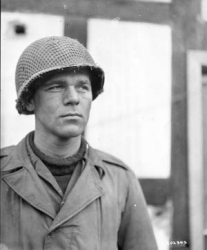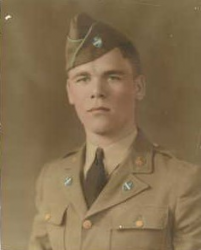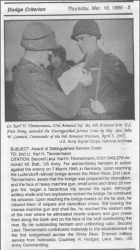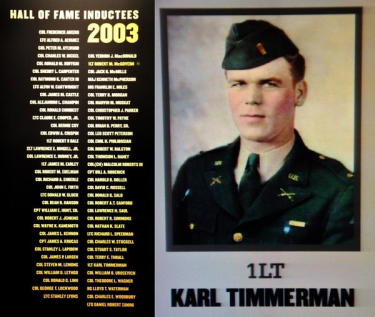
 |
|
|
||
|
Karl Heinrich Timmermann |
||||
|
Engagements: • World War II (1941 - 1945)• Korean War (1950 - 1953) |
||||
| Biography: | ||||
|
Karl Heinrich Timmermann Karl Heinrich Timmermann was born on 19 June 1922 at Frankfurt am Main, Hesse, Germany. His family moved to the United States in January 1924 and settled in Nebraska. Karl attended the Guardian Angels School in West Point, NE, and his interest in military history led him to participate in the Citizens Military Training Camps for two summers before his senior year of high school. He graduated in 1940. On 6 July 1940, Timmermann enlisted in the U.S. Army. He was stationed at Fort Lewis, Washington and assigned to the 15th Infantry Regiment of the 3rd Infantry Division. After the Japanese military attacked Pearl Harbor, his unit began training for war. In October 1942, the 3rd Infantry Division sailed for Morocco and Operation Torch, the invasion of French North Africa. Timmermann did not deploy with the division, as he had been selected for Officer Candidate School. He was commissioned as a Second Lieutenant on 16 February 1943 at Fort Benning, GA. After completing armored infantry training at Fort Riley, KS, 2LT Timmermann was assigned as a platoon leader in Company A of the 27th Armored Infantry Battalion, 9th Armored Division. On 28 September 1944, the 9th Armored Division arrived in France where the untested troops were placed in the quiet Ardennes sector in Belgium. That condition would soon change. On 16 December 1944, the Germans launched their winter Ardennes Counteroffensive that became known as the Battle of the Bulge. The 9th Armored Division, with no real combat experience, suddenly found itself engaged in very heavy fighting. The Division saw its severest action at Echternach, Luxembourg and at St. Vith and Bastogne, Belgium, its units fighting in widely separated areas. The 9th's stand at Bastogne held off the Germans long enough to enable the 101st Airborne Division to dig in for a defense of the city. On or about 17 December, as a junior officer, 2LT Timmermann, a platoon leader, was in the thick of the fighting near St. Vith. His A Company's entire kitchen staff and supply sergeant were captured and later executed by Combat Group Peiper (Kampfgruppe Peiper) part of the 1st SS Panzer Division of the Sixth Panzer Army commanded by Colonel Joachim (Jochen) Peiper. The Group murdered more than 80 US soldiers and Belgian prisoners in an atrocity known as the “Malmedy Massacre.” 2LT Timmermann was wounded in the arm by shell fragments during the fighting, but remained with his unit until relieved. The Germans twice announced that the 9th Armored Division had been destroyed during the battle, but it fought on, earning the nickname "Phantom Division." For his exemplary conduct in ground combat on or about 17 December, 2LT Timmermann was awarded the Bronze Star Medal. On 6 March 1945, the company commander of Company A was wounded in action and 2LT Timmermann was appointed by Lieutenant Colonel Leonard Engeman, Commander, 27th Armored Infantry Battalion, to take command of Able Company. He was also informed that Company A was going to be the advance guard for a push to the Rhine River. On 7 March, 2LT Timmermann’s Company A reached the Ludendorff Railroad Bridge across the Rhine River at Remagen, Germany, and he noticed that although the bridge was standing, it had been prepared for demolition. At about 1530 hours, under heavy German machine gun, small arms and direct 20-mm gun fire, 2LT Timmermann began a hazardous trip across the span with his under-strength A Company. 2LT Timmermann had designated half of his men to rush directly to the other side of the bridge to secure the east side and provide covering fire to the rest of the men. The other half swarmed the bridge, dodging machine gun fire, moving from girder to girder, and cutting wires and removing as many of the explosive charges as possible. Although artillery shells and two explosions (German Major Hans Scheller ordered that the bridge be blown up, but the bridge span had only lifted slightly and then dropped back into place) rocked the bridge, 2LT Timmermann continued his advance. Upon reaching the bridge towers on the far side, 2LT Timmermann cleared them of snipers and demolition crews. Still under intense German machine gun and shell fire, 2LT Timmermann reached the eastern side of the river where he eliminated hostile snipers and gun crews from along the bank and on the face of the bluff overlooking the river. 2LT Timmermann's personal bravery and bold actions contributed materially to the establishment of the first bridgehead across the Rhine River. 2LT Timmermann’s leadership, courageous actions and extraordinary heroism that day earned him the U.S. Army's second highest award for valor, the Distinguished Service Cross. All units of CCB/9 AIB of the 9th Armored Division were awarded the Presidential Unit Citation for their actions in taking and defending the Ludendorff Bridge during the Battle of Remagen in World War II. Presidential Unit Citation: Combat Command B, 9th Armored Division is cited for outstanding performance of duty in action from 28 February to 9 March 1945 in Germany. On 28 February, Combat Command B launched an attack from the vicinity of Soller and less than twenty-four hours later crossed the Erft River at Derkum, forcing the enemy into disorderly retreat, the unit headed south-east, reaching the heights west of Remagen on 7 March, where troops of the command could see the Ludendorff Bridge across the Rhine River with large numbers of German troops fleeing across it. At 1500 hours that day a prisoner was captured who revealed that the bridge was mined for demolition and was to be destroyed at 1600 hours. At 1535 hours, one column of Combat Company B reached the western approach to the bridge. The span was still intact. Although the destruction of the bridge was imminent, American troops unhesitatingly rushed across the structure in the face of intense enemy automatic weapons fire. An explosion rocked the bridge but did not destroy it. Engineers scrambled down the abutments, cutting wires leading to other demolition charges and disposing of hundreds of pounds of explosives by hurling them into the river. Bulldozer tanks, working under heavy artillery and small-arms fire, filled craters at the bridge approach to permit vehicular passage. Upon reaching the opposite bank, troops of Combat Command B fought gallantly and cleared the surrounding high ground. Although the strength of the span was unknown, tank units rumbled across the bridge after dark and lent their support to foot troops. Antiaircraft artillery men deployed their weapons so skillfully that in the ensuing days numerous enemy airplanes were destroyed in vain attempts to destroy the bridge. The superb skill, daring and esprit de corps displayed by each officer and man of Combat Command B, 9th Armored Division, in the dash to the Rhine, the capture of the Ludendorff Bridge, and the successful exploitation of this first bridgehead across Germany's formidable river barrier made an outstanding contribution to the defeat of the enemy. First Lieutenant Timmermann was discharged from the Army on 12 December 1945. He became a salesman in Nebraska. Return to Military Service Missing life in the Army, Timmermann tried to return as an officer, but all the officer billets were filled. So, on 28 October 1947, he enlisted at the rank of Technical Sergeant (E-7) in the Regular Army. Initially assigned as a recruiter, TSGT Timmermann was later an instructor with the Officers' Reserve Corps in Omaha, NE. With the start of the Cold War, on 26 December 1948 Timmermann was commissioned as a First Lieutenant and assigned to Fort Omaha and the Seventh Mechanized Cavalry Reconnaissance Troop of the Seventh Infantry Division. 1LT Timmermann landed with the 7th Infantry Division at Inchon, South Korea, in September 1950. He fought with his unit for several months before seeking medical treatment for ongoing abdominal pain. After being diagnosed with testicular cancer, he was sent back to the U.S. for treatment at Fitzsimons Army Hospital in Aurora, CO. Although surgery to remove the tumor was performed, the treatment was unsuccessful. Medals, Awards and Badge Distinguished Service Cross Distinguished Service Cross Citation The President of the United States of America, authorized by Act of Congress July 9, 1918, takes pleasure in presenting the Distinguished Service Cross to Second Lieutenant (Armor) Karl H. Timmermann (ASN: 0-1311343), United States Army, for extraordinary heroism in connection with military operations against an armed enemy while serving with the 27th Armored Infantry Battalion, 9th Armored Division, in action against enemy forces on 7 March 1945, in Germany. Upon reaching the Ludendorff railroad bridge across the Rhine River, Second Lieutenant Timmermann, aware that the bridge was prepared for demolition, and in the face of heavy machine gun, small arms and direct 20-mm. gun fire, began a hazardous trip across the span. Although artillery shells and two explosions rocket the bridge, he continued his advance. Upon reaching the bridge towers on the far side, he cleared them of snipers and demolition crews. Still braving the intense machine gun and shell fire, he reached the eastern side of the river where he eliminated hostile snipers and gun crews from along the bank and on the face of the bluff overlooking the river. By his outstanding heroism and unflinching valor, Second Lieutenant Timmermann contributed materially to the establishment of the first bridgehead across the Rhine River. Headquarters, First U.S. Army, General Orders No. 49 (March 27, 1945) Honors First Lieutenant Karl Heinrich Timmermann is honored in the following: ● A memorial dedicated to his actions capturing the Ludendorff Bridge during World War II was dedicated on March 7, 1995 in Timmerman Park in West Point, NE. Death and Burial First Lieutenant Karl Heinrich Timmermann died on 21 October 1951, at age 29 in Aurora, CO. He is buried at the Fort Logan National Cemetery in Denver, Denver County, CO, in Section H, Site195.https://www.findagrave.com/memorial/186253986/karl-heinrich-timmermann |
||||
| Honoree ID: 317202 | Created by: MHOH | |||
Ribbons
Medals
Badges
Honoree Photos
 |  |  |
 |  |
 |


